stop start CHEVROLET ASTRO PASSENGER 1994 1.G Owners Manual
[x] Cancel search | Manufacturer: CHEVROLET, Model Year: 1994, Model line: ASTRO PASSENGER, Model: CHEVROLET ASTRO PASSENGER 1994 1.GPages: 340, PDF Size: 16.86 MB
Page 72 of 340
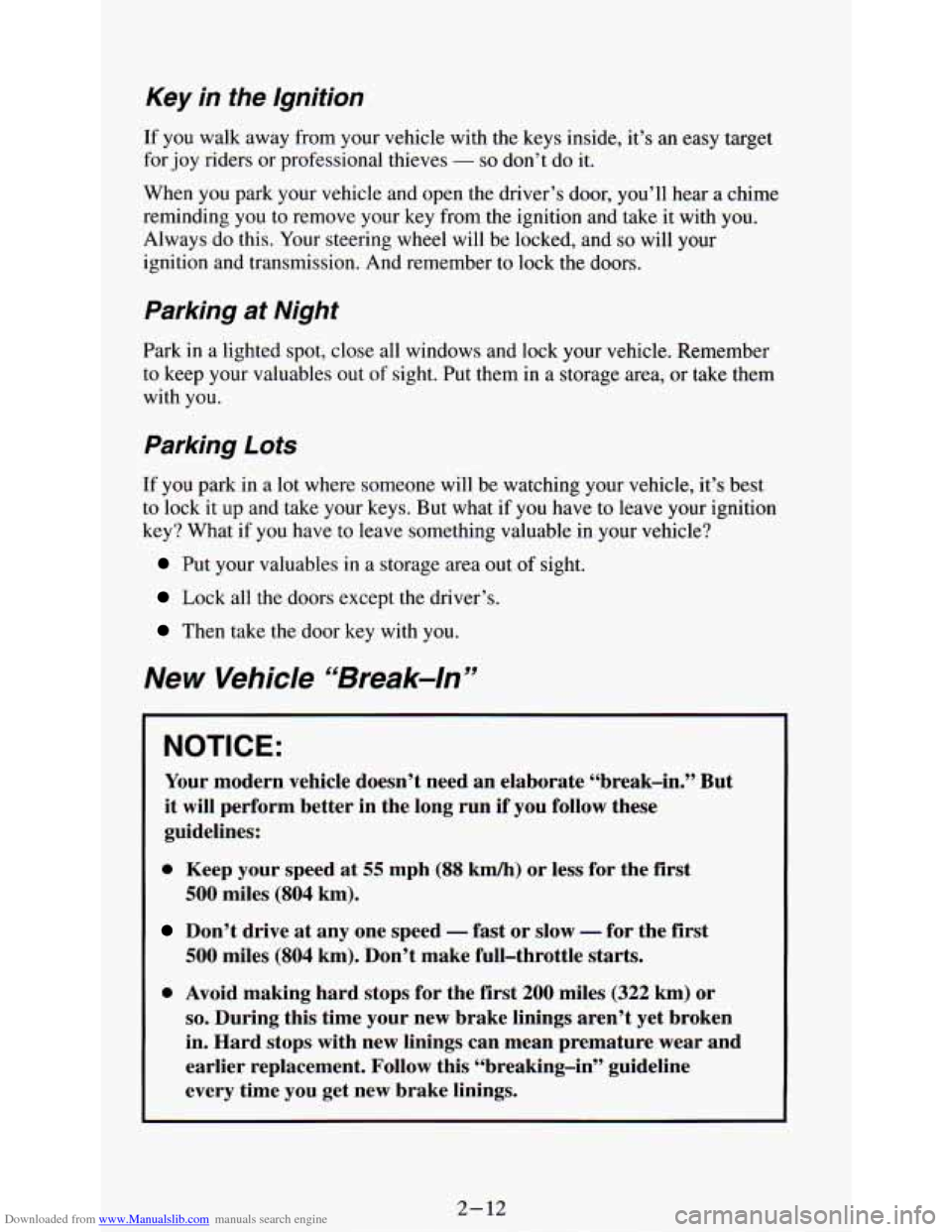
Downloaded from www.Manualslib.com manuals search engine Key in the Ignition
If you walk away from your vehicle with the keys inside, it’s an easy target
for joy riders or professional thieves
- so don’t do it.
When you park your vehicle and open the driver’s door, you’ll hear
a chime
reminding you to remove your key from the ignition and take it with you.
Always do this. Your steering wheel
will be locked, and so will your
ignition and transmission. And remember to lock the doors.
Parking at Night
Park in a lighted spot, close all windows and lock your vehicle. Remember
to keep your valuables out
of sight. Put them in a storage area, or take them
with you.
Parking Lots
If you park in a lot where someone will be watching your vehicle, it’s best
to lock
it up and take your keys. But what if you have to leave your ignition
key? What
if you have to leave something valuable in your vehicle?
Put your valuables in a storage area out of sight.
Lock all the doors except the driver’s.
Then take the door key with you.
New Vehicle “Break-In ”
NOTICE:
Your modern vehicle doesn’t need an elaborate “break-in.” But
it will perform better in the long run if you follow these
guidelines:
0 Keep your speed at 55 mph (88 km/h) or less for the first
500 miles (804 km).
Don’t drive at any one speed - fast or slow - for the first
500 miles (804 km). Don’t make full-throttle starts.
0 Avoid making hard stops for the first 200 miles (322 km) or
so. During this time your new brake linings aren’t yet broken
in. Hard stops with new linings can mean premature wear and
earlier replacement. Follow this “breaking-in” guideline
every time you get new brake linings.
2-12
Page 74 of 340
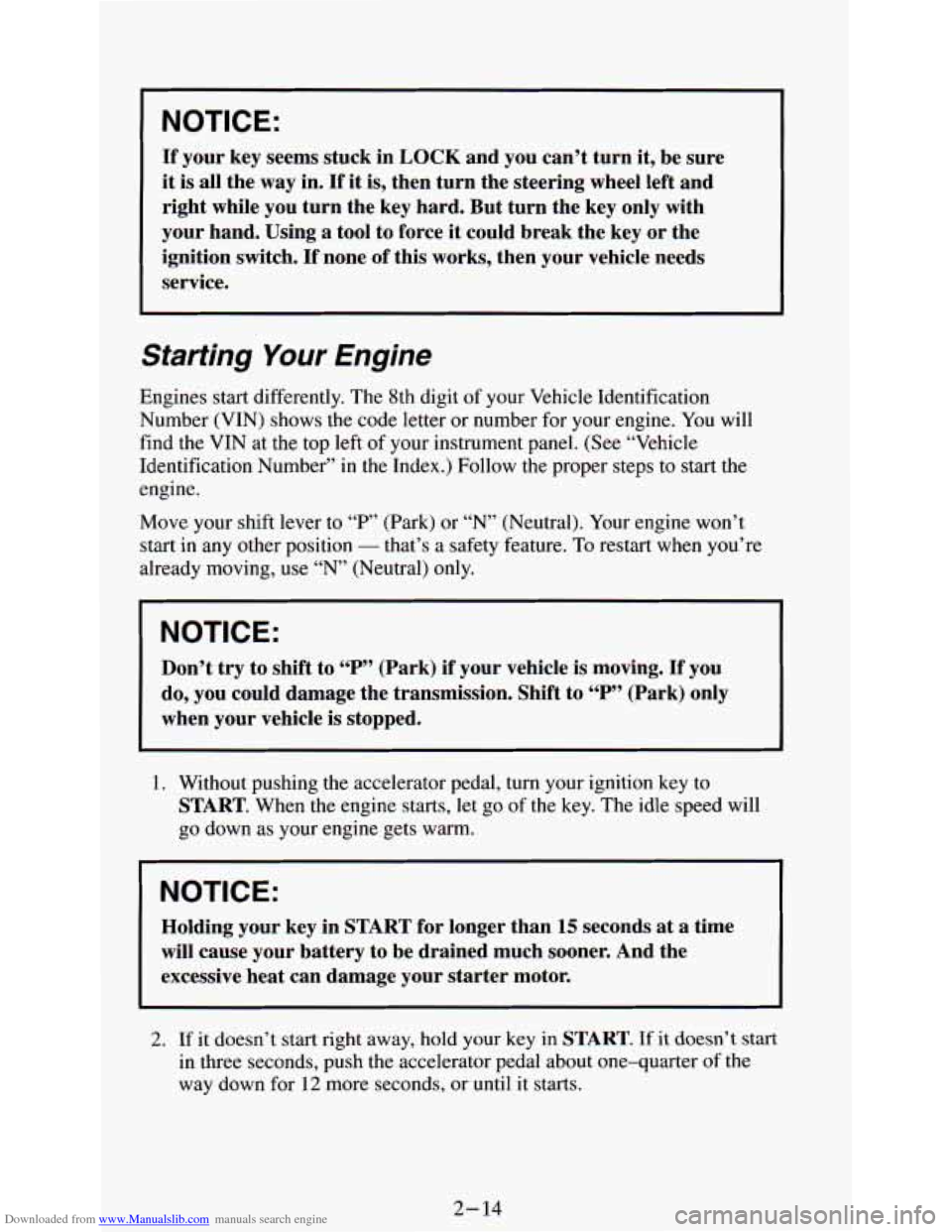
Downloaded from www.Manualslib.com manuals search engine I 1
I NOTICE:
If your key seems stuck in LOCK and you can’t turn it, be sure
it is
all the way in. If it is, then turn the steering wheel left and
right while you turn the key hard. But turn the key only with
your hand. Using
a tool to force it could break the key or the
ignition switch.
If none of this works, then your vehicle needs
service.
Farting Your Engine
Engines start differently. The 8th digit of your Vehicle Identification
Number (VIN) shows the code letter or number for your engine. You will
find the VIN at the top left of your instrument panel. (See “Vehicle
Identification Number”
in the Index.) Follow the proper steps to start the
engine.
Move your shift lever to
“P’ (Park) or “N” (Neutral). Your engine won’t
start in any other position
- that’s a safety feature. To restart when you’re
already moving, use
“N” (Neutral) only.
NOTICE:
Don’t try to shift to “P” (Park) if your vehicle is moving. If you
do, you could damage the transmission. Shift
to “P” (Park) only
when your vehicle
is stopped.
1. Without pushing the accelerator pedal, turn your ignition key to
START. When the engine starts, let go of the key. The idle speed will
go down as your engine gets warm.
NOTICE:
Holding your key in START for longer than 15 seconds at a time
will cause your battery to be drained much sooner. And the
excessive heat can damage your starter motor.
2. If it doesn’t start right away, hold your key in START. If it doesn’t start
in three seconds, push the accelerator pedal about one-quarter of the
way down for
12 more seconds, or until it starts.
2- 14
Page 75 of 340
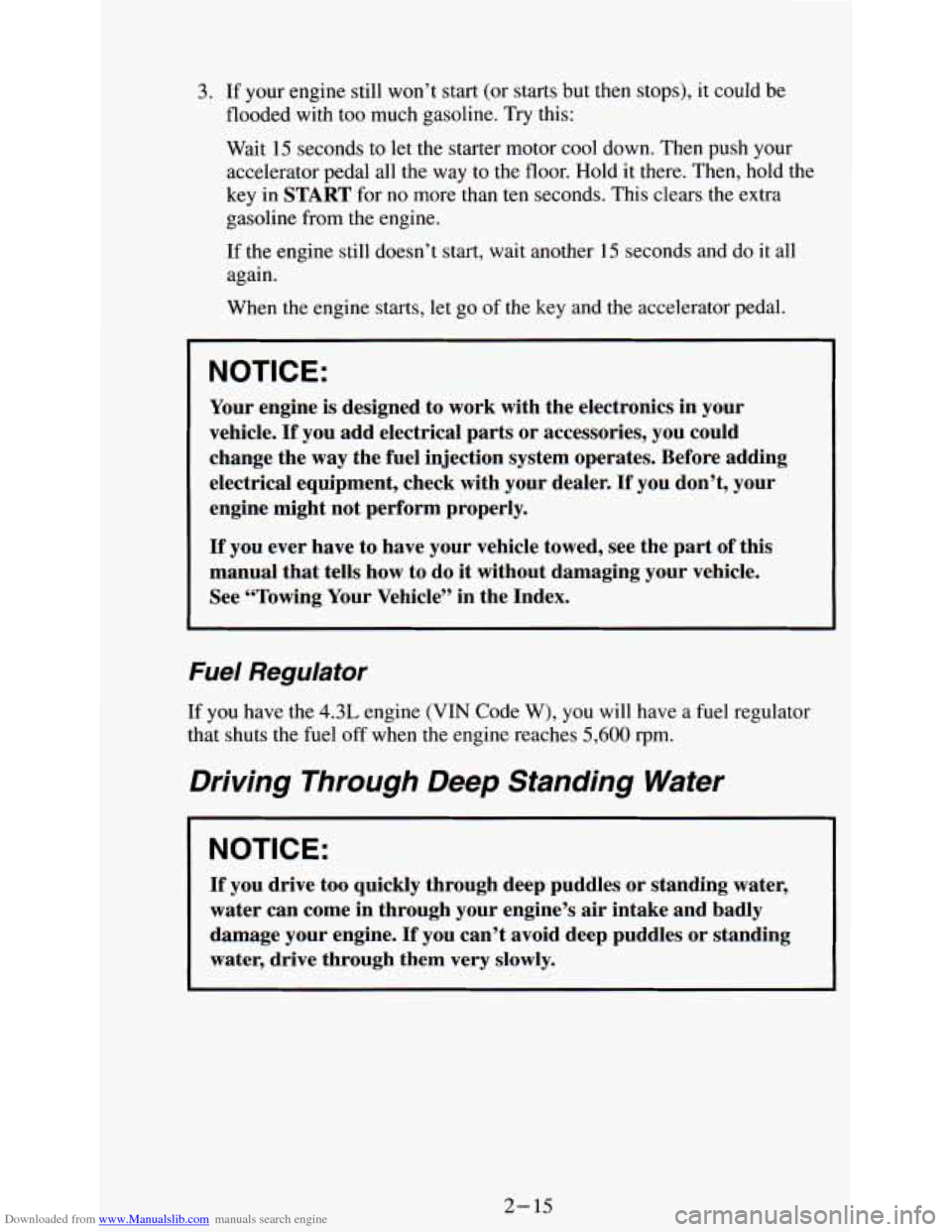
Downloaded from www.Manualslib.com manuals search engine 3. If your engine still won’t start (or starts but then stops), it could be
flooded with too much gasoline. Try this:
Wait 15 seconds to let the starter motor cool down. Then push your
accelerator pedal all the way to the floor. Hold it there. Then, hold the
key in
START for no more than ten seconds. This clears the extra
gasoline from the engine.
If the engine still doesn’t start, wait another 15 seconds and do it all
again.
When the engine starts, let go of the key and the accelerator pedal.
NOTICE:
Your engine is designed to work with the electronics in your
vehicle.
If you add electrical parts or accessories, you could
change the way the fuel injection system operates. Before adding
electrical equipment, check with your dealer.
If you don’t, your
engine might not perform properly.
If you ever have to have your vehicle towed, see the part of this
manual that tells how to do it without damaging your vehicle.
See “Towing Your Vehicle” in the Index.
Fuel Regulator
If you have the 4.3L engine (VIN Code W), you will have a fuel regulator
that shuts the fuel off
when the engine reaches 5,600 rpm.
Driving Through Deep Standing Water
NOTICE:
If you drive too quickly through deep puddles or standing water,
water can come in through your engine’s air intake and badly
damage your engine.
If you can’t avoid deep puddles or standing
water, drive through them very slowly.
2- 15
Page 78 of 340
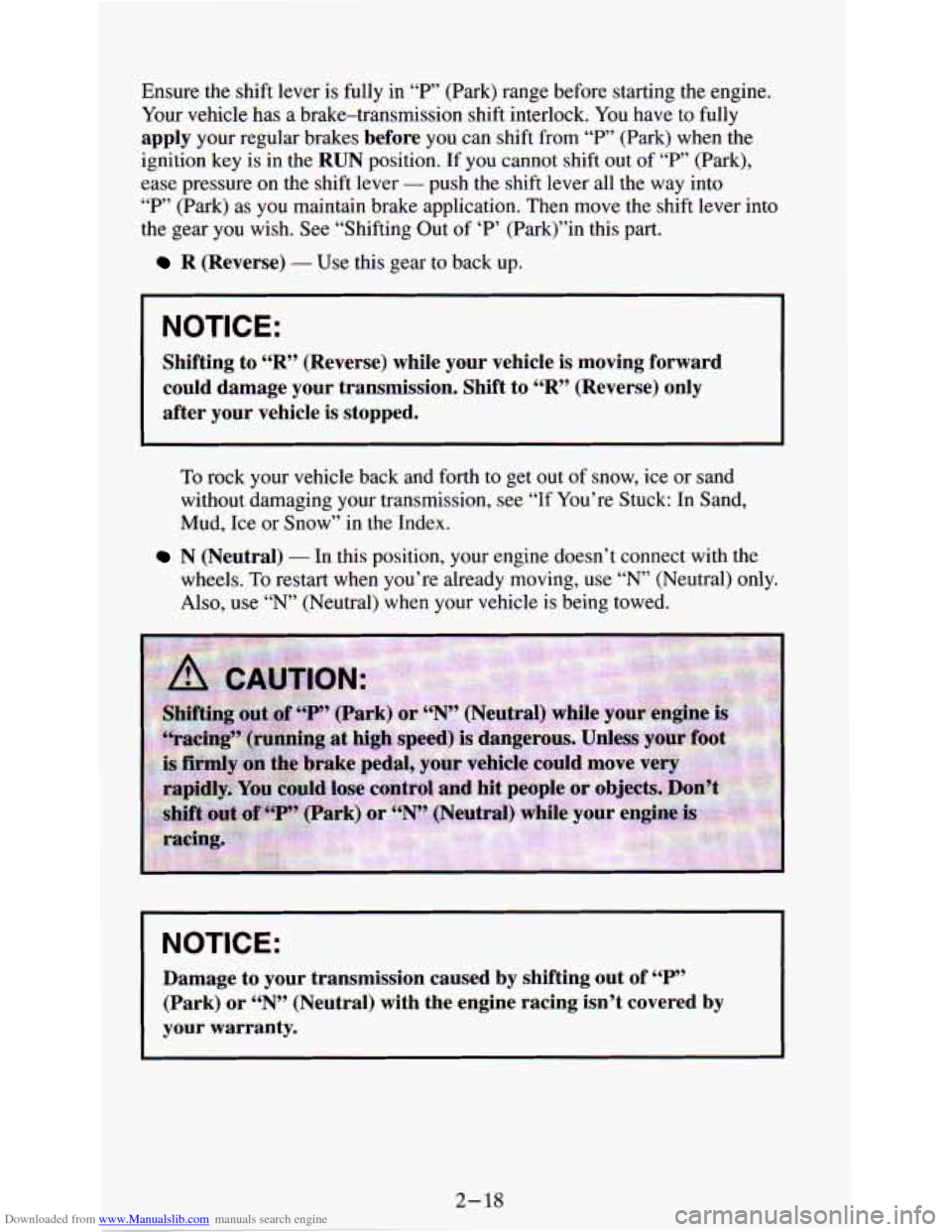
Downloaded from www.Manualslib.com manuals search engine Ensure the shift lever is fully in “P” (Park) range before starting the engine.
Your vehicle has
a brake-transmission shift interlock. You have to fully
apply your regular brakes before you can shift from “P” (Park) when the
ignition key is in the
RUN position. If you cannot shift out of “P’ (Park),
ease pressure on the shift lever
- push the shift lever all the way into
“P” (Park)
as you maintain brake application. Then move the shift lever into
the gear you wish. See “Shifting Out of ‘P’ (Park)”in this part.
R (Reverse) - Use this gear to back up.
NOTICE:
Shifting to “R” (Reverse) while your vehicle is moving forward
could damage your transmission. Shift to
“R” (Reverse) only
after your vehicle is stopped.
To rock your vehicle back and forth to get out of snow, ice or sand
without damaging your transmission, see
“If You’re Stuck: In Sand,
Mud, Ice
or Snow” in the Index.
N (Neutral) - In this position, your engine doesn’t connect with the
wheels. To restart when you’re already moving, use
“N’ (Neutral) only.
Also, use
“N” (Neutral) when your vehicle is being towed.
-
NOTICE:
Damage to your transmission caused by shifting out of “P”
(Park) or “N” (Neutral) with the engine racing isn’t covered by\
your warranty.
1
2- 18
Page 79 of 340
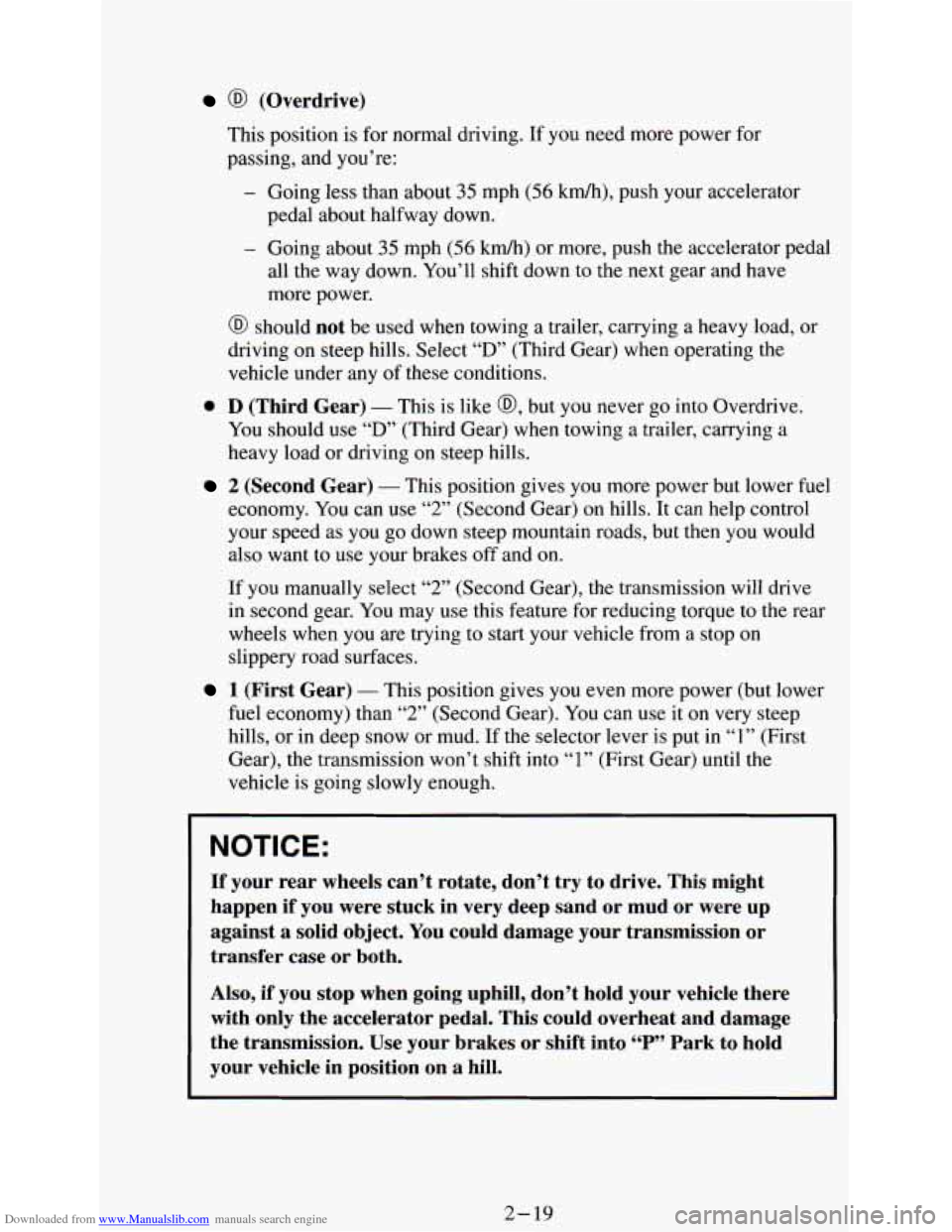
Downloaded from www.Manualslib.com manuals search engine @ (Overdrive)
This position is for normal driving. If you need more power for
passing, and you’re:
- Going less than about 35 mph (56 kdh), push your accelerator
- Going about 35 mph (56 kdh) or more, push the accelerator pedal
pedal
about halfway down.
all the way down. You’ll shift down to the
next gear and have
more power.
@ should not be used when towing a trailer, carrying a heavy load, or
driving on steep hills. Select
“D” (Third Gear) when operating the
vehicle under any of these conditions.
0 D (Third Gear) - This is like @, but you never go into Overdrive.
You should use
“D’ (Third Gear) when towing a trailer, carrying a
heavy load or driving on steep hills.
2 (Second Gear) - This position gives you more power but lower fuel
economy. You can use
“2” (Second Gear) on hills. It can help control
your speed as you go down steep mountain roads, but then you would
also want to use your brakes off and on.
If you manually select
“2” (Second Gear), the transmission will drive
in second gear. You may use this feature for reducing torque to the rear
wheels when you are trying to start your vehicle from a stop on
slippery road surfaces.
1 (First Gear) - This position gives you even more power (but lower
fuel economy) than
“2” (Second Gear). You can use it on very steep
hills, or in deep snow or mud. If the selector lever is put in
“1” (First
Gear), the transmission won’t shift into
“1” (First Gear) until the
vehicle is going slowly enough.
NOTICE:
If your rear wheels can’t rotate, don’t try to drive. This might
happen if you were stuck in very deep sand or mud or were up
against
a solid object. You could damage your transmission or
transfer case or both.
Also, if you stop when going uphill, don’t hold your vehicle there
with only the accelerator pedal. This could overheat and damage
the transmission. Use your brakes or shift into
“P” Park to hold
your vehicle in position on
a hill.
2-19
Page 93 of 340
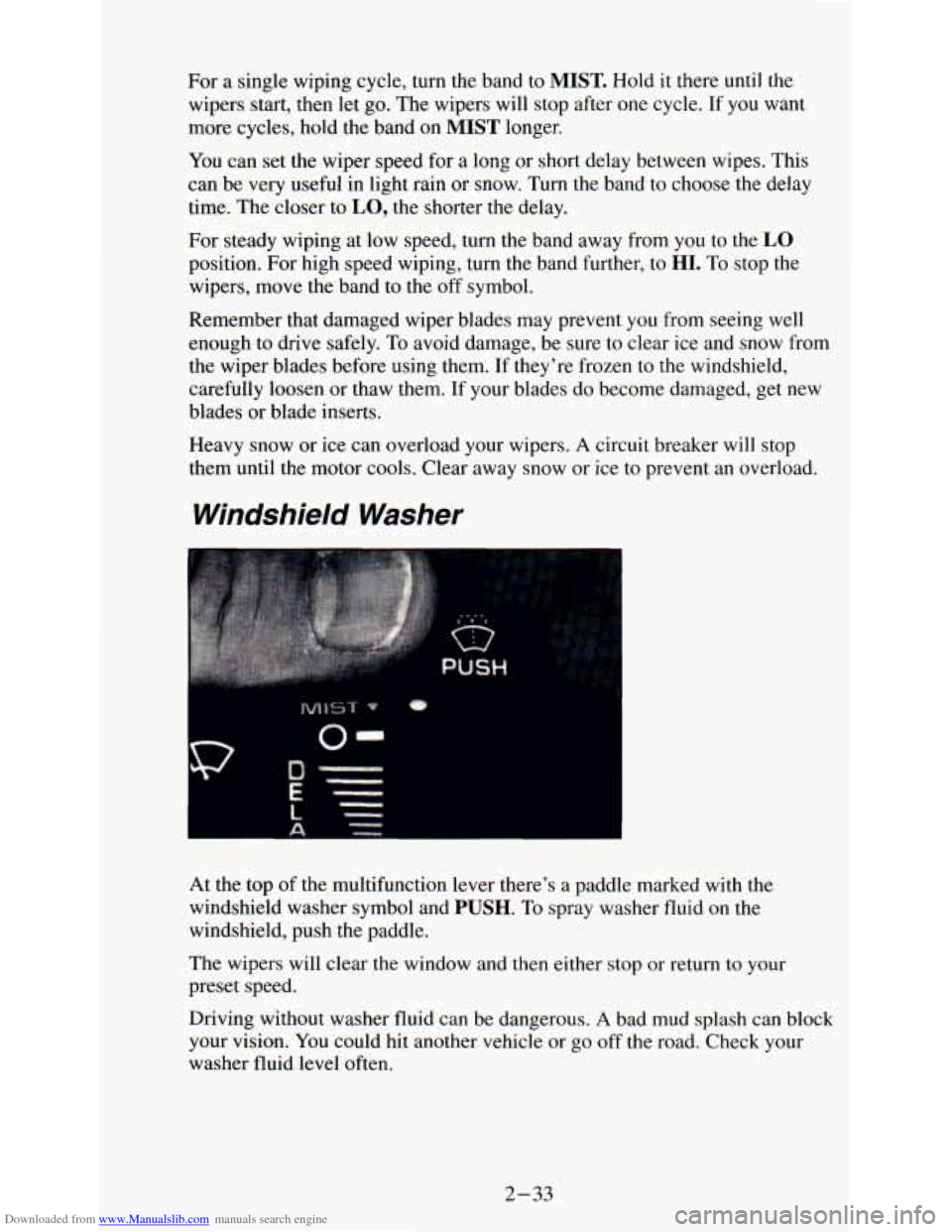
Downloaded from www.Manualslib.com manuals search engine For a single wiping cycle, turn the band to MIST. Hold it there until the
wipers start, then let go. The wipers will stop after one cycle. If
you want
more cycles, hold the band on
MIST longer.
You can
set the wiper speed for a long or short delay between wipes. This
can be very useful in light rain
or snow. Turn the band to choose the delay
time. The closer to
LO, the shorter the delay.
For steady wiping at low speed, turn the band away from you to the
LO
position. For high speed wiping, turn the band further, to HI. To stop the
wipers, move the band to the off symbol.
Remember that damaged wiper blades may prevent you from seeing well
enough to drive safely.
To avoid damage, be sure to clear ice and snow from
the wiper blades before using them. If they're frozen to the windshield,
carefully loosen or thaw them. If your blades do become damaged, get
new
blades or blade inserts.
Heavy snow or ice can overload your wipers.
A circuit breaker will stop
them until the motor cools. Clear away snow or ice to prevent an overload.
Windshield Washer
At the top of the multifunction lever there's a paddle marked with the
windshield washer symbol and
PUSH. To spray washer fluid on the
windshield, push the paddle.
The wipers will clear the window and then either stop or return to your
preset speed.
Driving without washer fluid can be dangerous.
A bad mud splash can block
your vision. You could hit another vehicle or go off the road. Check your
washer fluid level often.
2-33
Page 116 of 340
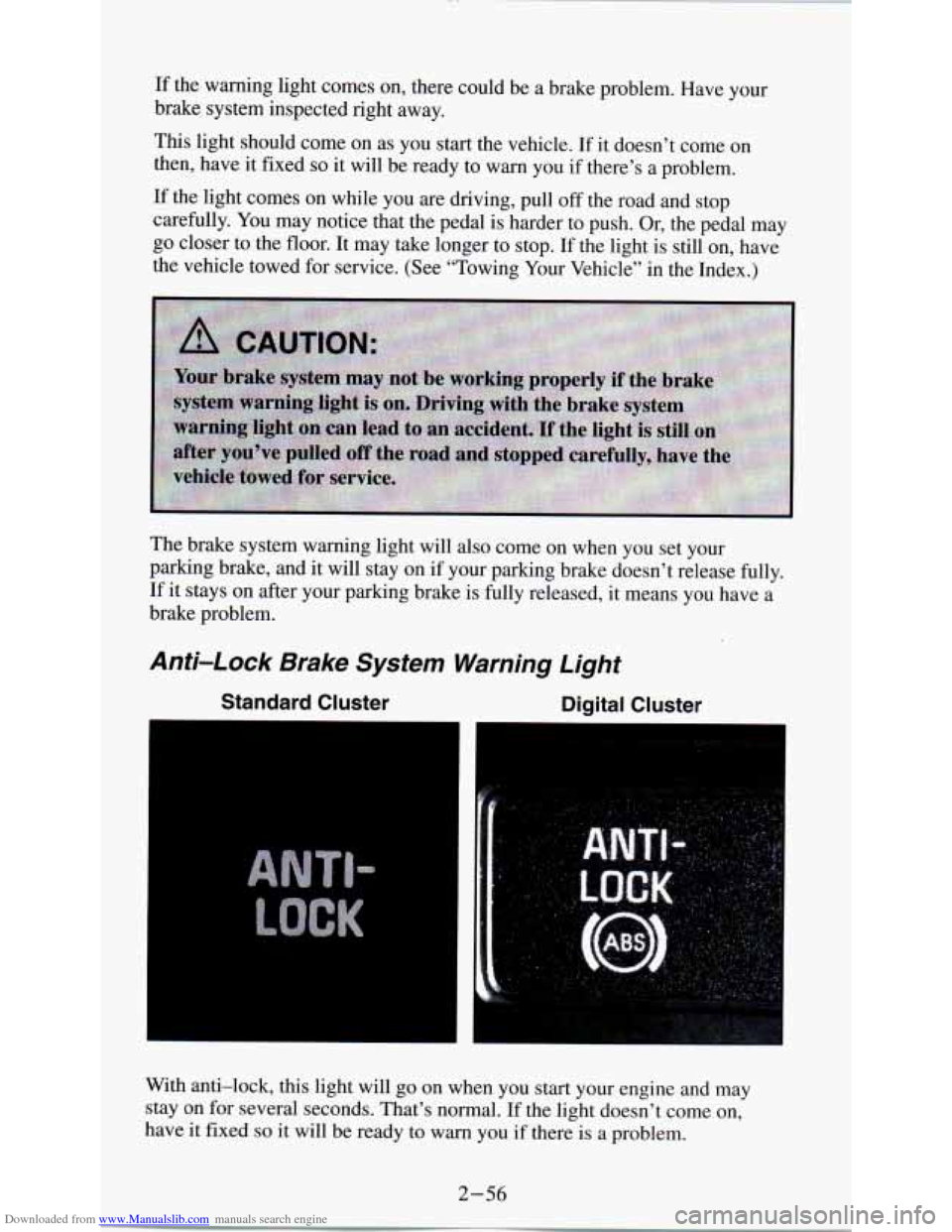
Downloaded from www.Manualslib.com manuals search engine If the warning light comes on, there could be a brake problem. Have your
brake system inspected right away.
This light should come on as you start the vehicle. If it doesn’t come on
then, have it fixed
so it will be ready to warn you if there’s a problem.
If the light comes on while you are driving, pull off the road and stop
carefully. You may notice that the pedal is harder to push.
Or, the pedal may
go closer to the floor. It may take longer to stop. If the light is still
on, have
the vehicle towed for service. (See “Towing Your Vehicle” in the Index.)
The brake system warning light will also come on when
YOU set your
parking brake, and it will stay on
if your parking brake doesn’t release fully.
If it stays on after your parking brake is fully released, it means YOU have a
brake problem.
Anti-Lock Brake System Warning Light
Standard Cluster Digital Cluster
I
With anti-lock, this light will go on when you start your engine and may
stay on for several seconds. That’s normal. If the light doesn’t come on,
have it fixed
so it will be ready to warn you if there is a problem.
2-56
Page 143 of 340
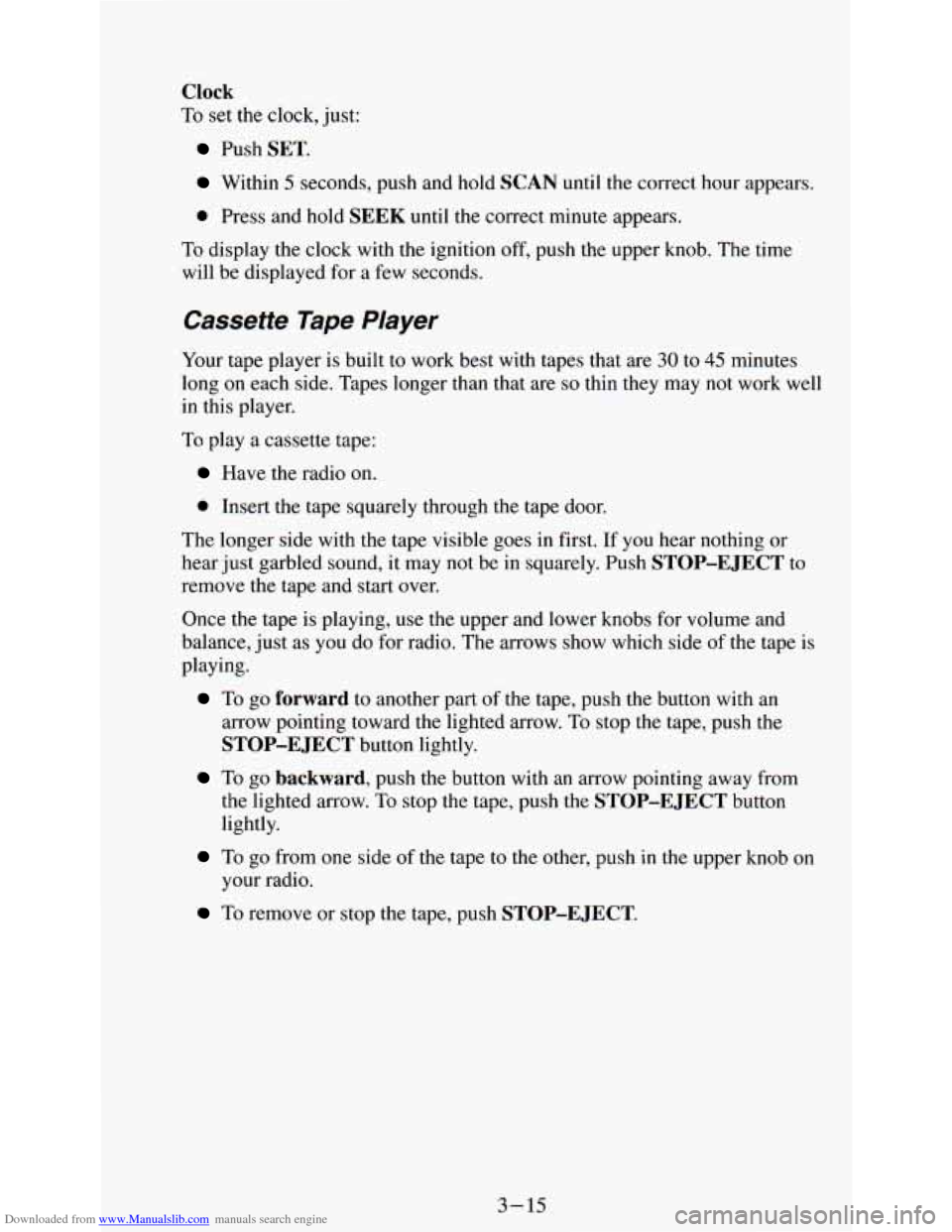
Downloaded from www.Manualslib.com manuals search engine Clock
To set the clock, just:
Push SET.
Within 5 seconds, push ant Ild SCA .N until the correct hour appears.
0 Press and hold SEEK until the correct minute appears.
To display the clock
with the ignition off, push the upper knob. The time
will be displayed for a few seconds.
Cassette Tape Player
Your tape player is built to work best with tapes that are 30 to 45 minutes
long on each side. Tapes longel [an that are
so thin they may not work well
in this player.
To play a cassette tape:
Have the radio on.
0 Insert the tape squarely rnrough the tape door.
The longer side with the tape visible goes in first. If you hear nothing or
hear just garbled sound, it may not be
in squarely. Push STOP-E JECT to
remove the tape and start over.
Once the tape is playing, use the upper and lower knobs for volume and
balance, just
as you do for radio. The arrows show which side of the tape is
playing.
To go forward to another part of the tape, push the button with an
arrow pointing toward the lighted arrow.
To stop the tape, push the
STOP-E JECT button lightly.
To go backward, push the button with an arrow pointing away from
the lighted arrow. To stop the tape, push the
STOP-EJECT button
lightly.
To go from one side of the tape to the other, push in the upper knob on
your radio.
To remove or stop the tape, push STOP-EJECT.
3-15
Page 146 of 340
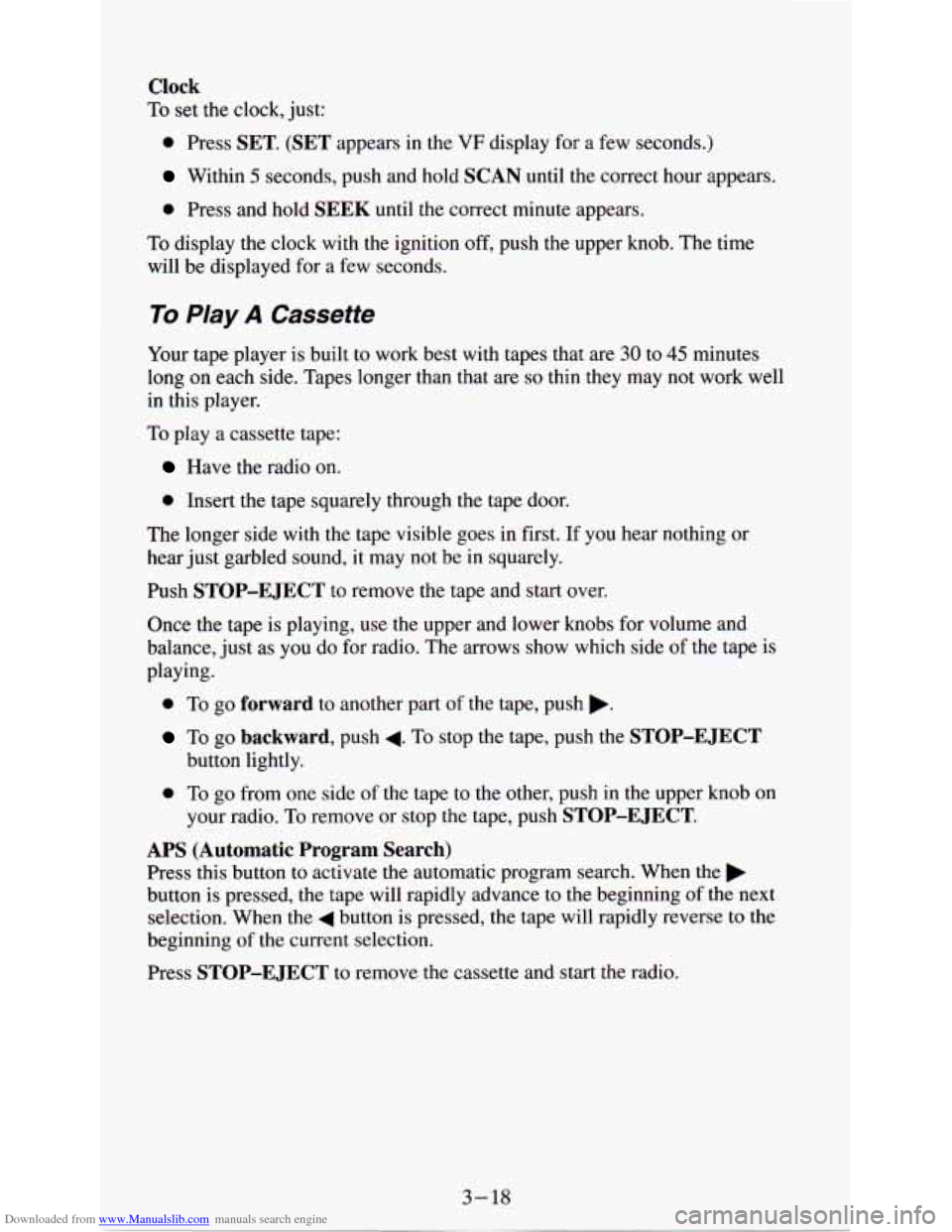
Downloaded from www.Manualslib.com manuals search engine Clock
To set the clock, just:
0 Press SET. (SET appears in the VF display for a few seconds.)
Within 5 seconds, push and hold SCAN until the correct hour appears.
0 Press and hold SEEK until the correct minute appears.
To display
the clock with the ignition off, push the upper knob. The time
will be displayed for a few seconds.
To Play A Cassette
Your tape player is built to work best with tapes that are 30 to 45 minutes
long on each side. Tapes longer than that are
so thin they may not work well
in this player.
To play a cassette tape:
Have the radio on.
0 Insert the tape squarely through the tape door.
The longer side with the tape visible goes in first. If you hear nothing or
hear just garbled sound, it may not be
in squarely.
Push
STOP-EJECT to remove the tape and start over.
Once the tape is playing, use the upper and lower knobs for volume and
balance, just as you do for radio. The arrows show which side of the tape is
playing.
0 To go forward to another part of the tape, push ,.
To go backward, push 4. To stop the tape, push the STOP-E JECT
button lightly.
0 To go from one side of the tape to the other, push in the upper knob on
your radio. To remove or stop the tape, push
STOP-EJECT.
APS (Automatic Program Search)
Press this button to activate the automatic program search. When the
button is pressed, the tape will rapidly advance to the beginning
of the next
selection. When the
4 button is pressed, the tape will rapidly reverse to the
beginning
of the current selection.
Press
STOP-EJECT to remove the cassette and start the radio.
3-18
Page 150 of 340
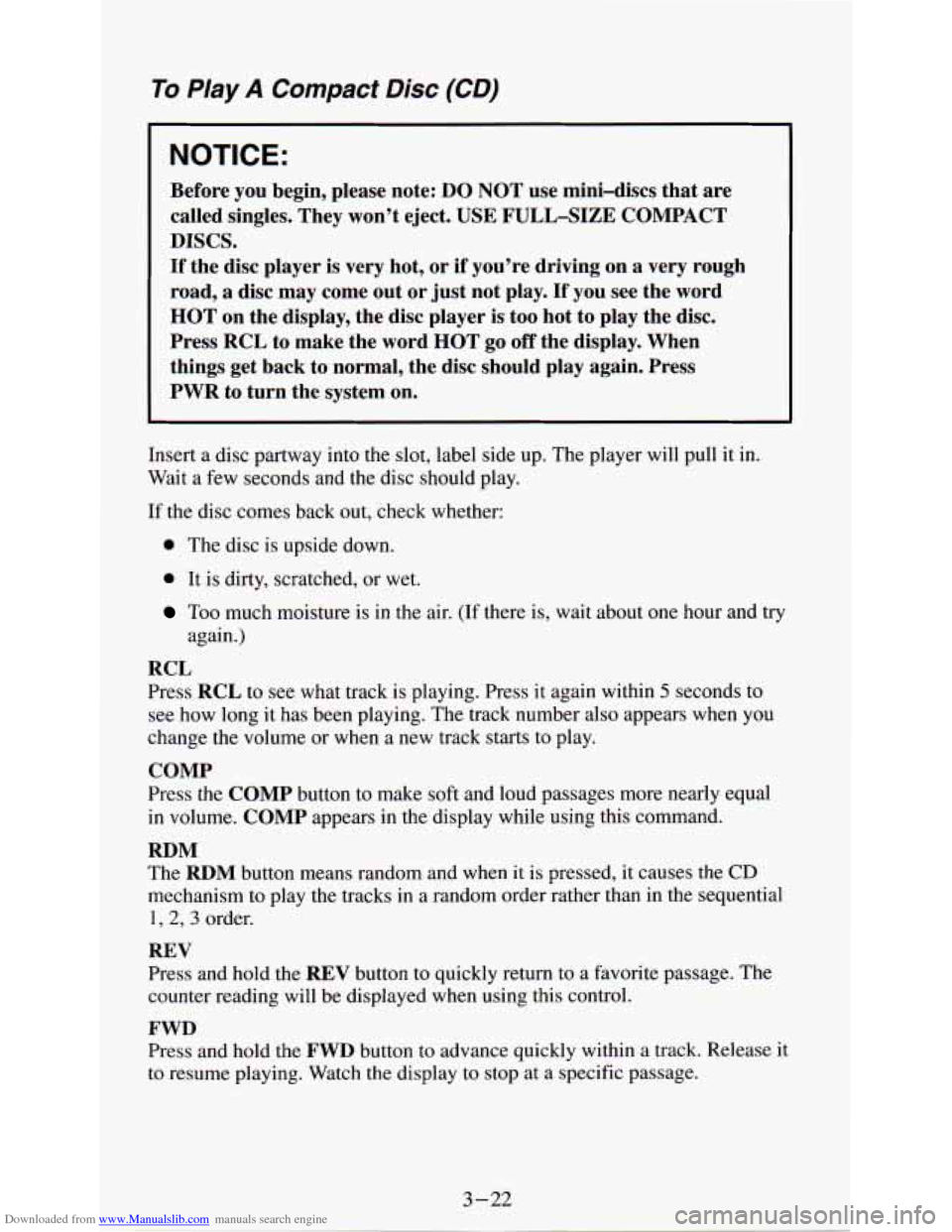
Downloaded from www.Manualslib.com manuals search engine To Play A Compact Disc (CD)
NOTICE:
Before you begin, please note: DO NOT use mini-discs that are
called singles, They won’t eject. USE FULL-SIZE COMPACT
DISCS.
If the disc player is very hot, or if you’re driving on a very rough
road,
a disc may come out or just not play. If you see the word
HOT
on the display, the disc player is too hot to play the disc.
Press RCL to make the word HOT
go off the display. When
things get back
to normal, the disc should play again. Press
PWR to turn the system
on,
Insert a disc partway into the slot, label side up. The player will pull it in.
Wait a few seconds and the disc should play.
If the disc comes back out, check whether:
0 The disc is upside down.
0 It is dirty, scratched, or wet.
Too much moisture is in the air. (If there is, wait about one hour and try
again.)
RCL
Press RCL to see what track is playing. Press it again within
5 seconds to
see how long it has been playing. The track number also appears when
you
change the volume or when a new track starts to play.
COMP
Press the COMP button
to make soft and loud passages more nearly equal
in volume. COMP appears in the display while using this command.
RDM
The RDM button means random and when
it is pressed, it causes the CD
mechanism to play the tracks in a random order rather than in the sequenti\
al
1,2,3 order.
REV
Press and hold the REV button to quickly return to a favorite passage. The
counter reading will be displayed when using this control.
FWD
Press and hold the FWD button to advance quickly within
a track. Release it
to resume playing. Watch the display to stop at a specific passage.